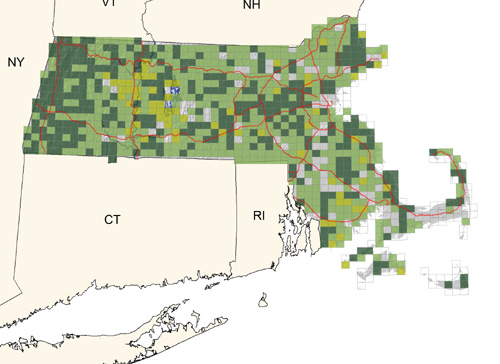Find a Bird - BBA1
Breeding Bird Atlas 1 Species Accounts
Red-eyed Vireo
Vireo olivaceus
Egg Dates
mid-May to late August
Number of Broods
one; possibly sometimes two

The Red-eyed Vireo, the most common and widely distributed vireo in Massachusetts, is primarily a bird of deciduous woodlands. It can be found nesting in mixed or deciduous forest growth, tree-bordered streets, and orchards, providing that these sites lie on the edge of extensive woodland. A break in the forest canopy created by the presence of a brook or bog increases the suitability of the locale for this species.
A few Red-eyed Vireos appear in late April and early May, but general arrival should not be expected until late May. The large number of transients seen is a reflection of this species’ abundance both as a migrant and summer resident in all sections of the state. Males appear first on territory. Courtship, which includes soft singing and wing quivering, begins later with the arrival of the females. A typical, but poorly understood, behavior observed throughout the nesting season is characterized by a bird’s drawing its feathers in tightly and swaying stiffly from side to side.
The male Red-eyed Vireo sings tirelessly from dawn until dusk, from spring until late summer, somewhat more sporadically through early autumn, and is one of a handful of birds that sings persistently through the heat of midday. The vocal effort of this vireo consists of short, abruptly rendered phrases, generally ending with a rising inflection and followed by a brief pause. The repetitive notes may be sung more than 40 times per minute and have earned the name Preacher Bird for the species. The field notes of the then young Edward Howe Forbush contain the following observation: “The longer pauses in song occurred only when a larva was captured and swallowed.”
Eggs may be deposited and incubated in an unfinished nest while the male continues to bring construction material. The usual clutch consists of three or four ovoid, dull, white eggs with fine small spots of reddish to dark brown or blackish color on the large end. Clutch sizes for 11 state nests were three eggs (6 nests), four eggs (4 nests), five eggs (1 nest). A twelfth nest contained two vireo eggs and two cowbird eggs (CNR, DKW). The incubation period spans 12 to 14 days, with brooding by both sexes. The males often sing while they are on the nest. The altricial young fledge in 12 days. In Massachusetts, nestlings have been reported from June 1 to August 17 and fledged young from June 14 to September 15 (CNR, EHF, Meservey, Blodget).
In early September, Red-eyed Vireos begin the southward migration to their wintering grounds in northern South America. They occur as transients through mid-October, with occasional birds lingering into November.
Map Legend and Data Summary
Atlas 1 data collected from 1975-1979


Note: common in mixed and deciduous woodlands (and adjacent shade trees) throughout the state
Joseph F. Kenneally, Jr.



